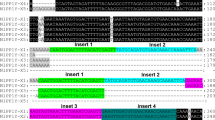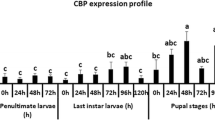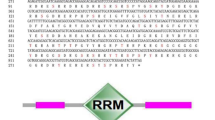Abstract
Ecdysteroids play an important role in regulating diverse physiological processes in arthropods, such as molting, metamorphosis, reproduction and diapause. Ecdysteroids mediate the response by binding to a heterodimeric complex of two nuclear receptors: the ecdysone receptor and the ultraspiracle (USP). To investigate the role of USP in development of the Asian gypsy moth (Lymantria dispar), a USP cDNA was obtained from the transcriptome of L. dispar and verified by PCR. In-depth profiling of transcript levels of L. dispar USP-1 (LdUSP-1) at different developmental stages and over time in third-instar larvae and different tissues isolated during the third-instar stage of L. dispar was then carried out. Transcript levels of LdUSP-1 were relatively high before 72 h in the third-instar larvae after ecdysis and in the adult male. The function of LdUSP-1 in molting was analyzed by knockdown of LdUSP-1 in third instar larvae using RNA interference. Silencing of LdUSP-1 significantly downregulated the transcript level of E75, an ecdysone-inducible gene, and of Sad, a Halloween gene. In addition, the duration of the third-instar stage was slightly shortened and larval mortality increased after the LdUSP-1 knockdown.






Similar content being viewed by others
References
Buszczak M, Segraves WA (2000) Insect metamorphosis: out with the old, in with the new. Curr Biol 10:830–833
Cao JJ, Liu YC, Yang YH, Zhang HJ, Li Z, Yang QP, Zhang SD, Zhang QW, Liu XX (2015) Molecular characterization and functional analysis of the ultraspiracle (USP) in the oriental fruit moth Grapholita molesta (Lepidoptera: Olethreutidae). Comp Biochem Physiol B 190:54–62
Forman BM, Samuels HH (1990) Interactions among a subfamily of nuclear hormone receptors: the regulatory zipper model. Mol Endocrinol 4:1293–1301
Giraudo M, Audant P, Feyereisen R, Goff GL (2013) Nuclear receptors HR96 and ultraspiracle from the fall armyworm (Spodoptera frugiperda), developmental expression and induction by xenobiotics. J Insect Physiol 59:560–568
Hall BL, Thummel CS (1998) The RXR homolog ultraspiracle is an essential component of the Drosophila ecdysone receptor. Development 125:4709–4717
Hannan GN, Hill RJ (2001) Lcusp, an ultraspiracle gene from the sheep blowfly, Lucilia cuprina: cDNA cloning, developmental expression of RNA and confirmation of function. Insect Biochem Mol Biol 31:771–781
Jindra M, Huang JY, Malone F, Asahina M, Riddiford LM (1997) Identification and mRNA developmental profiles of two ultraspiracle isoforms in the epidermis and wings of Manduca sexta. Insect Mol Biol 6:41–53
Kapitskaya M, Wang S, Cress DE, Dhadialla TS, Raikhel AS (1996) The mosquito ultraspiracle homologue, a partner of ecdysteroid receptor heterodimer: cloning and characterization of isoforms expressed during vitellogenesis. Mol Cell Endocrinol 12:119–132
Kumar MB, Fujimoto T, Potter DW, Deng Q, Palli SR (2002) A single point mutation in ecdysone receptor leads to increased ligand specificity: implications for genes witch applications. Proc Natl Acad Sci USA 99:14710–14715
Lenaerts C, Wielendaele PV, Peeters P, Broeck JV, Marchal E (2016) Ecdysteroid signalling components in metamorphosis and development of the desert locust, Schistocerca gregaria. Insect Biochem Mol Biol 75:10–23
Marchal E, Vandersmissen HP, Badisco L, Van de Velde S, Verlinden H, Iga M, Wielendaele PV, Huybrechts R, Simonet G, Smagghe G, Broeck J (2010) Control of ecdysteroidogenesis in prothoracic glands of insects: a review. Peptides 31:506–519
Martin D, Maestro O, Cruz J, Mané-Padrós D, Bellés X (2006) RNAi studies reveal a conserved role for RXR in molting in the cockroach Blattella germanica. J Insect Physiol 52:410–416
Moeller ME, Danielsen ET, Herder R, O’Connor MB, Rewitz KF (2013) Dynamic feedback circuits function as a switch for shaping a maturation-inducing steroid pulse in Drosophila. Development 140:4730–4739
Nakagawa Y, Henrich VC (2009) Arthropod nuclear receptors and their role in molting. Special Issue Proteases Proteolysis Health Dis 276:6128–6157
Parvy JP, Wang P, Garrido D, Maria A, Blais C, Poidevin M, Montagne J (2014) Forward and feedback regulation of cyclic steroid production in Drosophila melanogaster. Development 141:3955–3965
Pfaffl MW (2001) A new mathematical model for relative quantification in real-time RT-PCR. Nucleic Acids Res 29:e45
Raikhel AS, Brown MR, Belles X (2005) Hormonal control of reproductive processes. Compr Mol Insect Sci 3:433–491
Renaud JP, Moras D (2000) Structural studies on nuclear receptors. Cell Mol Life Sci CMLS 57:1748–1769
Sakurai S (2005) Feedback regulation of prothoracic gland activity. Compr Mol Insect Sci 3:409–431
Song QS, Gilbert LL (1998) Alterations in ultraspiracle (USP) content and phosphorylation state accompany feedback regulation of ecdysone synthesis in the insect prothoracic gland. Insect Biochem Mol Biol 28:849–860
Tamura K, Dudley J, Nei M, Kumar S (2007) MEGA4: molecular evolutionary genetics analysis (MEGA) software version 4.0. Mol Biol Evol 24:1596–1599
Tavva VS, Dinkins RD, Palli SR, Collins GB (2006) Development of a methoxyfenozide-responsive genes witch for applications in plants. Plant J 45:457–469
Thompson JD, Gibson TJ, Plewniak F, Jeanmougin F, Higgins DG (1997) The CLUSTAL_X windows interface: flexible strategies for multiple sequence alignment aided by quality analysis tools. Nucleic Acids Res 25:4876–4882
Tsai MJ, O’Malley BW (1994) Molecular mechanisms of action of steroid/thyroid receptor superfamily members. Annu Rev Biochem 63:451–486
Verma P, Tapadia MG (2015) Early gene broad complex plays a key role in regulating the immune response triggered by ecdysone in the Malpighian tubules of Drosophila melanogaster. Mol Immunol 66:325–339
Vogtli M, Imhof MO, Brown NE, Rauch P, Spindler-Barth M, Lezzi M, Henrich VC (1999) Functional characterization of two ultraspiracle forms (CtUSP-1 and CtUSP-2) from Chironomus tentans. Insect Biochem Mol Biol 29:931–942
Wang SF, Li C, Zhu J, Miura K, Miksicek RJ, Raikhel AS (2000) Differential expression and regulation by 20-hydroxyecdysone of mosquito ultraspiracle isoforms. Dev Biol 218:99–113
Wurtz JM, Bourguet W, Renaud JP, Vivat V, Chambon P, Moras D, Gronemeyer H (1996) A canonical structure for the ligand-binding domain of the nuclear receptors. Nat Struct Biol 3:87–94
Xu QY, Deng P, Li A, Zhang Q, Mu LL, Fu KY, Guo WC, Li GQ (2019) Functional characterization of ultraspiracle in Leptinotarsa decemlineata using RNA interference assay. Insect Mol Biol. https://doi.org/10.1111/imb.12580
Yan T, Chen H, Sun Y, Yu X, Xia L (2016) RNA Interference of the ecdysone receptor genes EcR and USP in grain aphid (Sitobion avenae F). Affects its survival and fecundity upon feeding on wheat plants. Int J Mol Sci 17(12):2098
Yao TP, Forman BM, Jiang ZY, Cherbas L, Chen JD, McKeown M, Cherbas P, Evans RM (1993) Functional ecdysone receptor is the product of EcR and ultraspiracle genes. Nature 366:476–479
Zheng WW, Yang DT, Wang JX, Song QS, Gilbert LI, Zhao XF (2010) Hsc70 binds to ultraspiracle resulting in the upregulation of 20-hydroxyecdsone-responsive genes in Helicoverpa armigera. Mol Cell Endocrinol 315:282–291
Acknowledgements
This research was supported by Grants from the Natural Science Foundation of China (31770688), the Fundamental Research Funds for the Central Universities (2572017AA17), the Ph.D. Programs Foundation of HeZe University (XY18BS06), and the Ph.D. Programs Foundation of HeZe University (XY18BS05).
Author information
Authors and Affiliations
Corresponding author
Ethics declarations
Conflict of interest
The authors have no conflicts of interest to declare.
Additional information
Publisher's Note
Springer Nature remains neutral with regard to jurisdictional claims in published maps and institutional affiliations.
Project funding: This research was supported by Grants from the Natural Science Foundation of China (31770688), the Fundamental Research Funds for the Central Universities (2572017AA17), the Ph.D. Programs Foundation of HeZe University (XY18BS06), and the Ph.D. Programs Foundation of HeZe University (XY18BS05).
The online version is available at http://www.springerlink.com
Corresponding editor: Chai Ruihai.
Rights and permissions
About this article
Cite this article
Wen, R., Zhao, Q., Wang, B. et al. Molecular characterization and functional analysis of USP-1 by RNA interference in the Asian gypsy moth Lymantria dispar. J. For. Res. 31, 1923–1931 (2020). https://doi.org/10.1007/s11676-019-00944-7
Received:
Accepted:
Published:
Issue Date:
DOI: https://doi.org/10.1007/s11676-019-00944-7




